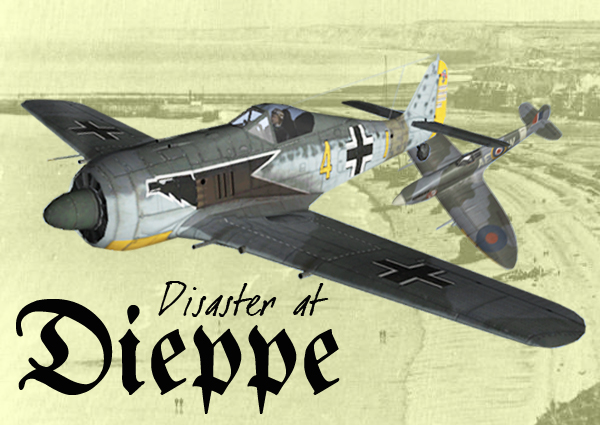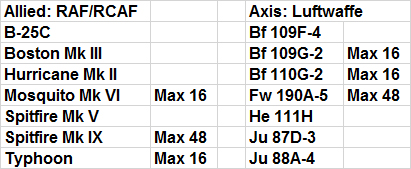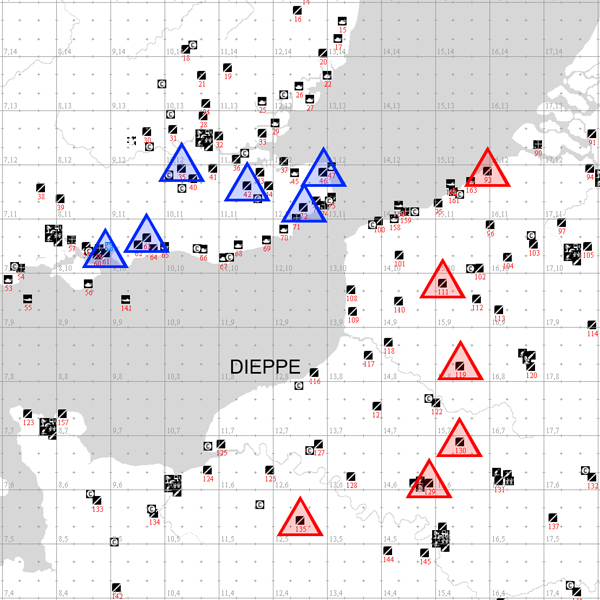Disaster at Dieppe

Â
19 August, 1942Â
Â
1942 was a hard year of the war for the Allies. Great Britain could not boast a single victory in the field. British and Commonwealth troops in North Africa were being contained and driven back by the Africa Corps. In the Far East the Japanese were dismembering and occupying substantial parts of the former British Empire. The Americans were still feeling the after effects of their material losses at Pearl Harbor and struggling to maintain what was left of their Philippine Army and the Russians were being steadily pushed back as Hitler developed his thrust into the Caucusus. The immediate outlook was bleak.
Â
The most serious situation was on the Russian Front where immense armies were pitted against each other in a fight to the death. There seemed to be no way of stopping the German offensive. Stalin called loudly and often for an offensive in the West to reduce some of the pressure on his armies. At this stage of the war a Russian military collapse was considered a possibility with a consequent catastrophic effect on the whole Allied war effort.
Â
The Russian plea was strongly supported by the Americans, even though they themselves were unable to provide significant material support, or troops, for an offensive in the West. There was significant agitation by several senior American military and naval leaders, that, unless an offensive in the West was developed and executed within the short term, they would concentrate their efforts in the Pacific against the Japanese. The general public also agitated for offensive action to support the beleaguered Russians. Mass rallies held in both Trafalgar Square in London and Madison Square gardens in New York, during April 1942, called for "a second front now!"
Â
There was, therefore, unbearable pressure on Churchill and the British Chiefs of Staff to develop and execute an offensive operation on the Western front - an operation that would, it was hoped, either draw German divisions from the Russian front, or at least hold the existing divisions in France in place thus preventing additional reinforcements being sent to the East.It was against this menacing background that the Dieppe raid was planned and executed.Â
Â
Operation Jubilee took place on the morning of August 19, 1942. The forces attacked at five different points on a front roughly 16 kilometers long. Four simultaneous flank attacks were to go in just before dawn, followed half an hour later by the main attack on the town of Dieppe itself. Canadians were the force for the frontal attack on Dieppe, and also went in at gaps in the cliffs at Pourville, four kilometers to the west, and at Puys to the east. British commandos were assigned to destroy the coastal batteries at Berneval on the eastern flank, and at Varengeville in the west. While the Allied air forces were able to provide protection for the ships off Dieppe from the Luftwaffe (the German air force), the cost was high. The Royal Air Force lost 106 aircraft, the highest single-day total of the war. The Royal Canadian Air Force lost 13 aircraft.
Â
By early afternoon, August 19, 1942, Operation Jubilee was over and a retreat command had been ordered. Debate over the merit of the raid continues to the present day. Some believe that it was a useless slaughter, others maintain that is was necessary for the success of the invasion of the continent two years later on D-Day. Without question, the Raid on Dieppe was studied carefully in planning later attacks against the enemy-held coast of France. There were improvements in the technique, fire support and tactics, which reduced D-Day casualties to an unexpected minimum. The lessons learned at Dieppe were instrumental in saving countless lives on June 6, 1944.
Â
This FSO Setup will attempt to recreate the air battle that took place over Dieppe on the 19th of August 1942
Â
- Sides: 50% Allies / 50% AxisÂ
Â
- Plane Set/Plane Set Rules
Â

Â
- Bf 109G-2 - 2x WGr21 Disabled
- Bf 110G-2 - 4x WGr21 Disabled, 2x WGr21 Disabled
- Fw 190A-5 - 2x WGr21 Disabled
- Mosquito Mk VI - 8x RP-3 60lb Rockets Disabled
- Typhoon - 8x RP-3 60lb Rockets Disabled, 1000lb Bombs Disabled, 4x RP-3 60lb Rockets and 2x44 gallon DTs Disabled.
- Only aircraft with minimums must be flown.
- Requirements Indicate # of Pilots.
- Formations are enabled but not required.
- Certain Aircraft will only be active from certain fields. Please refer to the Objectives and Orders.
Aircraft Scoring

Â
- Objects (Guns, Radar) destroyed at Ships will score points.
- Ships sunk with torpedo double point total.Â
Â

Â

Â

Â
ACE MISSIONS:
Â
Each side will have one mandatory Ace mission per frame. These frames will represent notable pilots of the time and theater. One pilot from each side will designated an "Ace" Pilot. They must fly the Aces listed aircraft. The Aces must be relayed to the Admin CM before launch. They will be scored as follows.Â
Â
Ace Pilot = 20 Points
Ace Pilot Kills = 20 Points
Â
So for example if an Ace Pilot is shot down they are worth 20 points to the other side. Likewise, every victory an Ace Pilot lands they will be rewarded 20 points.
Â
ALLIED ACES
Â
Â
FRAME 1 – Donald Kingaby - (Spitfire Mk IX) - Kingaby was a veteran of the Battle of Britain claiming 11 victories and several damaged aircraft including four 109s in one day on November 15th 1940. In 1941 during the beginning of the Channel lean, Kingaby would shoot down 12 more enemy aircraft and was dubbed the "109 specialist" by the English papers. In November of 1941 he was promoted to Pilot Officer and was rested from operations until spring of 1942 whereÂ
he would continue to perform missions over France. Kingaby would claim his 19th victory during the Dieppe battle, a Do 217. Kingaby would continue to serve on the Channel Front scoring his last kill on June 30th 1944. He would be taken out of front line action soon afterwards and ended the war with 21 victories. Kingaby moved from England to the US and passed away in May of 1990.
Â
FRAME 2 – Wilfred Duncan-Smith - (Spitfire Mk IX) - Duncan-Smith began his victory count on June 18th 1941 with the destruction of a Bf 109E. Duncan-Smith was with 603 Squadron when he became ill in late November 1941. When he returned he took the lead of 64 Squadron and the first unit in Fighter Command to recieve the Spitfire Mk IX. In August of 1942 promoted to Wing Commander of the North Weald Wing. Duncan-Smith would share a victory during the Dieppe battle but would also be shot down during the ordeal, having to be rescued from the English Channel. He was rested from operations but would return to action in 1943 at Malta the Sicily Invasion. Duncan Smith was credited with 17 enemy aircraft shot down in aerial combat. He was awarded the Distinguished Service Order and Bar and the DFC and two Bars in recognition of his bravery, he passed away in December of 1996.
Â
FRAME 3 – Tony Gaze - (Spitfire Mk IX) - Gaze was an Australian who joined the RAF in 1940 and began flying combat missions with 610 Squadron in March, 1941. Gaze claimed his first kill in June 1941 against a Bf 109. He claimed 1 kill during the Dieppe battle and was awarded his second DFC. The following year in 1943 Gaze was shot down near Dieppe and was forced to evade capture and flee to Spain with help of the French Resistance. Gaze would go onto the be the first Australian to shoot down and Me 262 on February 14th, 1945 and would share a Ar 234 on 12 April 1945. He would end the war flying the Gloster Meteor accruing 13.5 victories during World War 2. He would go onto to be a race car driver, he passed away in Australia in 2013.
Â
AXIS ACES
Â
FRAME 1 – Egon Mayer (Fw 190A-5) - Egon Mayer had been a Western Front veteran since the Invasion of France, claiming his first victory on 13th Jun 1940. He often flew as the wingman of Helmut Wick during the Battle of Britain where he would claim 3 more victories before being shot down into the channel. JG 2 was withdrawn from the battle and Mayer would not return to the Channel Front until 1941 where in July he would claim his 19th and 20th victory and be awarded the Knights Cross of the Iron Cross. During the Dieppe Battle on August 19th, while flying the Fw 190 Mayer would claim his 49th and 50th victory which also happened to be his birthday. Mayers victory tally was at 102 when he was killed in action on March 2nd 1944 by USAAF Thunderbolts.
Â
FRAME 2 – Josef "Sepp" Wurmheller (Fw 190A-5) - Wurmheller saw his first action 30 days after World War 2 began during the Phony War Period claiming a Fairey Battle near Saarbrucken. He would also claim four victories during the Battle of Britain where he would be shot down and hospitalized until March of 1941 afterwards he would shoot down two more Spitfires in May before being transferred East for the subsequent invasion of Russia. He would shoot down 9 more enemy aircraft there before being transferred back to the Channel front in July. Wurmhellers best day as fighter pilot came during the Dieppe Invasion where he would shoot down 6 Spitfires and 1 Blenhiem bomber. Wurmheller was killed in action on June 22nd 1944, his victories stood at 102. He was posthumously awarded the Knights Cross of the Iron Cross with Oak Leaves and Swords.
Â
FRAME 3 – Siegfried Schnell (Fw 190A-5) - Schnell shot down his first enemy aircraft on 14th May during the Invasion of France. He would accumulate 20 victories by November of 1940 and was awarded the Knights Cross. Schnell remained on the Channel Front and during a two day span on July 8th and 9th would shoot down 9 Spitfires bringing his total to 44 victories and the award of Oak Leaves to his Knights Cross. His total would reach 52 during the infamous Channel
Dash in February of 1942 and would shoot down 5 Spitfires during the Dieppe battle on August 19th 1942 bring his total to 71. He would eventually be killed on the Eastern Front on February 25th, 1944 near Leningrad. He was credited with 93 victories.
Â
SUGGESTED OR HISTORICAL AIRCRAFT SKINS -Â This is a list of suggested or historical skins, while some might not be historical to the time or theater, they were also considered to be the most appropriate.
ALLIED -Â
B-25C -Â 180BS by Fencer
Boston - Default
Hurricane Mk IIC - Default
Mosquito MK VI - Default, 305 Squadron by Cactus, 464 Squadron by Cactus.
Spitfire Mk V - 310 Squadron by 417Jocko, 401 Squadron by 417Jocko, 401 Squadron by Kev367th, 303 Squadron by Kazan
Spitfire Mk IX - Default, 133 Squadron by F77, 303 Squadron by Kazan, 403 Squadron by 417Jocko, 402 Squadron by 417Jocko
Typhoon - 56 Squadron by Greebo
AXIS
Â
BF 109F-4 - 1./Jg 26 by Devil5O5, 3./Jg 1 by Bubi, 9./Jg 2 By Devil5O5
Â
BF 109G-2 -Â II/Jg 11 by Fencer
FW 190A-5  - Default, 1./Jg 1 by Bubi, 9./Jg 2 by Devil5O5, I/Jg 1 by Krusty, III/Jg 26 by Archiaus, III/Jg 2 by Kweassa,Â
Stab./Jg 26 by Devil5O5
Â
BF 110G-2 -Â Â I/NJG 6 by MotleyCH
Â
JU 87D-3 - Default
Â
JU 88A-4 -Â Â Default, 3./Kg 54 by Greebo
Â
HE 111H - Default
Â
Arena Settings:
Â
- BoB40 Terrain
- Icon Range – Friendly 3k, Enemy 3k.
- No Radar
- Fighter and Bomber Warning Range - 63360 (12 miles)
- Tower Range – 63,360 (for display to match the above Fighter and Bomber Warning)
- External view for bombers (F3) - On
- Friendly Collisions - Off
- Enemy Collisions - On
- Kill Shooter - Off
- Fuel - 1.0
- Ack - 0.4
- Formations - Enabled
- Bombsite calibration - Main Arena Standard
- Visibility - 17 miles
- Object Downtime – full (200)
- Winds - None
- Game Clock:
Â
           Frame 1: 05:00Â
           Frame 2: 12:00Â
           Frame 3: 17:00Â
Â
Specific Rules:
Â
You can contact all the squads on your side here.
Â
http://ahevents.org/fso_email/mail_address.html
Â
Please note the updated rules.
Â
http://ahevents.org/fso-related/fso-rules.html
Â
Original Design by Baumer 2009
Updated by Nefarious 2016